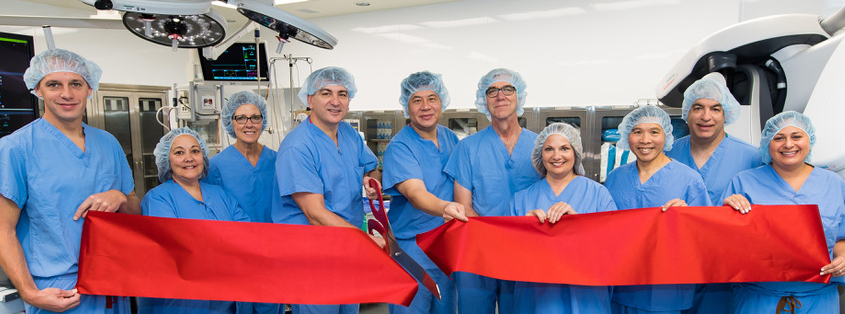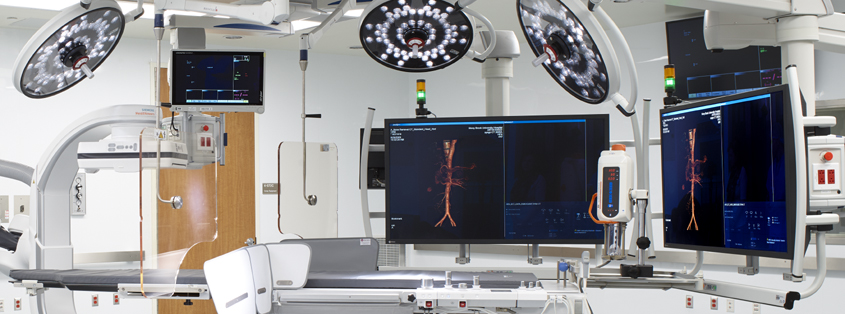STATE-OF-THE-ART HYBRID OPERATING ROOMS INSTALLED AT UNIVERSITY HOSPITAL TO ENHANCE PATIENT CARE
Leading the Way in Patient Care with the Latest Technology

| Left to right: Eugene Deal, RN, CNOR, hybrid OR clinician; Donna Hoffman, RN, associate director of nursing, perioperative services; Mary Catalano, CASC, administrative director, perioperative services; Apostolos Tassiopoulos, MD, director, Stony Brook Vascular Center and chief, vascular and endovascular surgery; Shang Loh, MD, program director, vascular and endovascular surgery and associate director, Aortic Center; Mark Talamini, MD, chairman of surgery and chief, surgical services; Carol Gomes, chief operating officer; Tong Joo Gan, MD, chairman of anesthesiology; Kenneth Rosenfeld, MD, director, perioperative services; and Allyson Silver, MPH, associate director of operations, surgical services. (Click on image to enlarge.) |
STONY BROOK, NY, October 13, 2017 — Today, Stony Brook University Hospital opened two fully-equipped hybrid operating rooms (ORs) to provide patients with minimally invasive surgical procedures that are shorter, safer, and more convenient.
Our new hybrid ORs feature the most up-to-date, technologically sophisticated equipment. Called the Siemens Artis Pheno, it has the most dynamic imaging capabilities available today. Stony Brook is the first hospital in the Northeast — and the third hospital in the country — that currently uses this type of imaging equipment.
The hybrid ORs, which are each about twice as large as traditional ORs, have the usual surgical equipment plus a large complement of very sophisticated imaging technology that normally isn't located in a traditional OR. Having imaging capabilities, such as the latest CT scanners, in the OR allows surgeons to perform complex procedures with real-time image guidance.
Hybrid ORs are specially designed and equipped to make today's surgeries safer and easier for patients and the medical professionals who are in the OR with the patient:
- Having advanced imaging equipment available during surgery allows for faster, more precise placement of surgical tools and implants.
- Surgeries generally proceed more quickly because everything the surgeon needs is right in the room. There's no need to move to another location for additional procedures or imaging.
- The newest technologies require less radiation and less contrast material — the dye that is needed to give doctors a better view of tissues. This means greater safety for patients.
- Results for patients may be enhanced due to the shorter surgical times, smaller incisions needed for minimally invasive procedures and the greater imaging accuracy.
- If surgeons determine that other procedures, including traditional open surgery, are needed for an individual patient, the open surgery can be done safely and immediately in the same room.

| Inside one of our new hybrid ORs. Note the image of the aorta on the scanners; it's an example of what the surgeon can view with the patient lying on the table having a cardiovascular procedure. (Click on image to enlarge.) |
Our hybrid ORs feature the most sophisticated imaging capabilities available today. The Siemens Artis Pheno allows surgeons to use fluoroscopic imaging — advanced x-rays — with special capabilities, such as the DynaCT system, which offers:
- Computerized tomography (CT or CAT scan) that combines a series of images from different angles to create detailed cross-sections of different structures in the body.
- Rotational imaging and 3D reconstructions, so the surgeon can see the patient's internal structures, including the veins, arteries, and heart from all angles, and confirm exact, correct placement of stents, valves, and other implants.
- The ability to fuse different images and imaging studies to see true 3D images.
- Higher resolution images to make diagnosis and treatment more accurate.
- A reduction in the amount of contrast that the patient needs, which makes the procedures safer.
- About a 30% reduction in the amount of radiation that patients and surgical personnel are exposed to, which increases safety for everyone.
- Accurate final images at the procedure's completion, which can enhance overall results for the patient.
- Shorter procedure time, which may reduce the amount of anesthesia needed.
- A possible reduction in overall costs to patients due to shorter operation times and less anesthesia.
Stony Brook's new hybrid ORs are predominantly used for cardiac and vascular procedures, but will also be equipped for trauma, spine, and urology surgeries.
The technology in these specialized ORs allows cardiovascular surgeons to safely and efficiently perform minimally invasive procedures, such as:
- Percutaneous (through the skin) valve replacements or repairs such as transcatheter aortic valve replacement (TAVR) that are done instead of open heart surgery.
- Cardiac catheterization and coronary interventions — to identify and open a blocked artery in the heart with angioplasty and stenting.
- Electrophysiology — tests to assess and treat the heart's electrical system.
- Endovascular procedures (using a catheter inserted through the skin to diagnose and treat vascular disease), such as:
- Endovascular repair of aortic aneurysms in the abdomen or chest (EVAR, TEVAR).
- Endovascular repair of aortic dissections.
- Stent graft implantations.
- Endovascular treatment of peripheral artery disease (PAD) with angioplasty and stenting.
- Embolization of visceral artery aneurysms and vascular malformations.
- Hybrid (part open and part endovascular) intervention to treat complex vascular problems.
Depending on the procedure, patients may have sedation or general anesthesia. Some will be able to go home the same day and others will stay in the hospital for a short time.
| Stony Brook's Dedication to Excellence in Patient Care. The hybrid ORs are part of Stony Brook's commitment to offer the best possible care for patients. We're committed to leading the way in patient care with the latest technology. Our new ORs are staffed by a multidisciplinary team of highly-trained and experienced specialists, including surgeons, interventionalists, nurses, anesthesiologists, and technicians. The new rooms are located in University Hospital on the fourth floor adjacent to the traditional OR. Stony Brook also has a hybrid OR at Stony Brook Southampton Hospital. |
For consultations with our cardiac surgeons, please call 631-444-1820. For consultations with our vascular surgeons, please call 631-638-1670.
